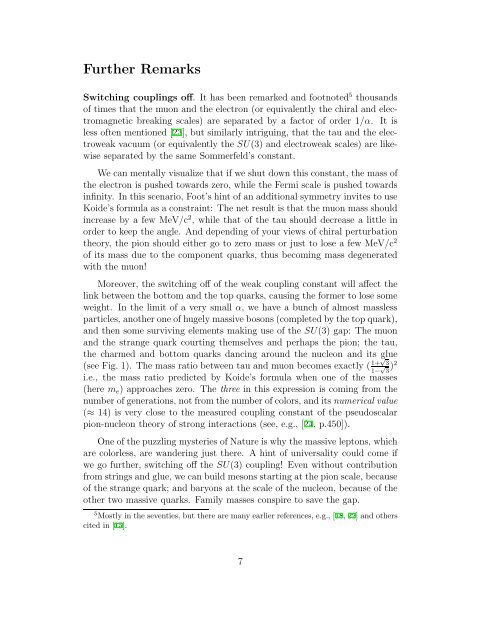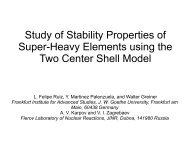The strange formula of Dr. Koide
The strange formula of Dr. Koide
The strange formula of Dr. Koide
Create successful ePaper yourself
Turn your PDF publications into a flip-book with our unique Google optimized e-Paper software.
Further Remarks<br />
Switching couplings <strong>of</strong>f. It has been remarked and footnoted 5 thousands<br />
<strong>of</strong> times that the muon and the electron (or equivalently the chiral and electromagnetic<br />
breaking scales) are separated by a factor <strong>of</strong> order 1/α. It is<br />
less <strong>of</strong>ten mentioned [23], but similarly intriguing, that the tau and the electroweak<br />
vacuum (or equivalently the SU(3) and electroweak scales) are likewise<br />
separated by the same Sommerfeld’s constant.<br />
We can mentally visualize that if we shut down this constant, the mass <strong>of</strong><br />
the electron is pushed towards zero, while the Fermi scale is pushed towards<br />
infinity. In this scenario, Foot’s hint <strong>of</strong> an additional symmetry invites to use<br />
<strong>Koide</strong>’s <strong>formula</strong> as a constraint: <strong>The</strong> net result is that the muon mass should<br />
increase by a few MeV/c 2 , while that <strong>of</strong> the tau should decrease a little in<br />
order to keep the angle. And depending <strong>of</strong> your views <strong>of</strong> chiral perturbation<br />
theory, the pion should either go to zero mass or just to lose a few MeV/c 2<br />
<strong>of</strong> its mass due to the component quarks, thus becoming mass degenerated<br />
with the muon!<br />
Moreover, the switching <strong>of</strong>f <strong>of</strong> the weak coupling constant will affect the<br />
link between the bottom and the top quarks, causing the former to lose some<br />
weight. In the limit <strong>of</strong> a very small α, we have a bunch <strong>of</strong> almost massless<br />
particles, another one <strong>of</strong> hugely massive bosons (completed by the top quark),<br />
and then some surviving elements making use <strong>of</strong> the SU(3) gap: <strong>The</strong> muon<br />
and the <strong>strange</strong> quark courting themselves and perhaps the pion; the tau,<br />
the charmed and bottom quarks dancing around the nucleon and its glue<br />
(see Fig. 1). <strong>The</strong> mass ratio between tau and muon becomes exactly ( 1+√ 3<br />
1− √ 3 )2<br />
i.e., the mass ratio predicted by <strong>Koide</strong>’s <strong>formula</strong> when one <strong>of</strong> the masses<br />
(here m e ) approaches zero. <strong>The</strong> three in this expression is coming from the<br />
number <strong>of</strong> generations, not from the number <strong>of</strong> colors, and its numerical value<br />
(≈ 14) is very close to the measured coupling constant <strong>of</strong> the pseudoscalar<br />
pion-nucleon theory <strong>of</strong> strong interactions (see, e.g., [24, p.450]).<br />
One <strong>of</strong> the puzzling mysteries <strong>of</strong> Nature is why the massive leptons, which<br />
are colorless, are wandering just there. A hint <strong>of</strong> universality could come if<br />
we go further, switching <strong>of</strong>f the SU(3) coupling! Even without contribution<br />
from strings and glue, we can build mesons starting at the pion scale, because<br />
<strong>of</strong> the <strong>strange</strong> quark; and baryons at the scale <strong>of</strong> the nucleon, because <strong>of</strong> the<br />
other two massive quarks. Family masses conspire to save the gap.<br />
5 Mostly in the seventies, but there are many earlier references, e.g., [18, 22] and others<br />
cited in [15].<br />
7



